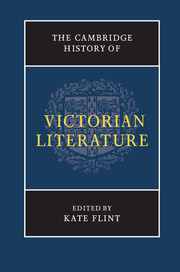Book contents
- Frontmatter
- Introduction
- PART I AUTHORS, READERS, AND PUBLISHERS
- PART II WRITING VICTORIA’s ENGLAND
- PART III MODES OF WRITING
- PART IV MATTERS OF DEBATE
- 15 Education
- 16 Spirituality
- 17 Material
- 18 Economics and finance
- 19 History
- 20 Sexuality
- 21 Aesthetics
- 22 Science and literature
- 23 Subjectivity, psychology, and the imagination
- 24 Cityscapes
- 25 The rural scene: Victorian literature and the natural world
- 26 ‘The annihilation of space and time’: literature and technology
- PART V SPACES OF WRITING
- PART VI VICTORIAN AFTERLIVES
- Select bibliography
- Index
21 - Aesthetics
from PART IV - MATTERS OF DEBATE
Published online by Cambridge University Press: 28 March 2012
- Frontmatter
- Introduction
- PART I AUTHORS, READERS, AND PUBLISHERS
- PART II WRITING VICTORIA’s ENGLAND
- PART III MODES OF WRITING
- PART IV MATTERS OF DEBATE
- 15 Education
- 16 Spirituality
- 17 Material
- 18 Economics and finance
- 19 History
- 20 Sexuality
- 21 Aesthetics
- 22 Science and literature
- 23 Subjectivity, psychology, and the imagination
- 24 Cityscapes
- 25 The rural scene: Victorian literature and the natural world
- 26 ‘The annihilation of space and time’: literature and technology
- PART V SPACES OF WRITING
- PART VI VICTORIAN AFTERLIVES
- Select bibliography
- Index
Summary
Derived from the Greek aesthesis, for English-speakers at the beginning of Victoria’s reign ‘aesthetics’ was a largely technical, not yet anglicized term for ‘the science which treats of the conditions of sensuous perception’. First used in 1750 by Alexander Baumgarten in something like the modern sense (‘the philosophy or theory of taste, or of the beautiful in nature and art’, OED), ‘aesthetik’ was embraced by both Schiller and Hegel. Coleridge attempted unsuccessfully to introduce it into English as an unfamiliar but useful term to designate a convergence of form, feeling, and intellect, but it was not widely adopted to denote the study of beauty in nature or the visual arts until the 1850s, and was not common in discussions of literature or music before the 1870s. The term’s slow anglicization was due in part to its association with German metaphysicians regarded, in Britain, with suspicion. The work of the systematic German philosophers (Kant and Hegel) and their interest in the place of aesthetic pleasure in a theory of mind had few serious students in Britain between Coleridge and Pater. By 1875, James Sully, author of the Encyclopedia Britannica’s first entry on aesthetics, gives due place to Kant, Hegel, and other German philosophers.
Most Victorian aesthetic speculation took place not through formal philosophical investigation but through literature and criticism. It was driven by the need to make sense of a perceived abundance of art and literature (from both past and present) and to defend the arts under conditions felt as increasingly hostile: industrialization, worship of the ‘Goddess of Getting On’, and dependence on a market of under-educated middle and aspiring-middle classes.
- Type
- Chapter
- Information
- The Cambridge History of Victorian Literature , pp. 444 - 465Publisher: Cambridge University PressPrint publication year: 2012



